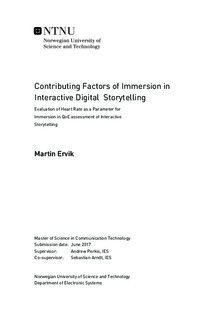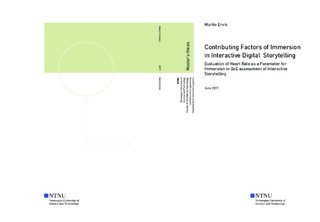| dc.description.abstract | Technology has improved to the point where the focus area of quality assessment is shifting from the delivery focused Quality of Service (QoS), to a more user-focused assessment field, Quality of Experience (QoE). This enables us to use physiological measurements of users to assess the QoE. Although widely accepted and used, there is little research on using physiological measurements for assessing QoE in the new display technology, e.g.telling an interactive digital story by using head-mounted-displays (HMD) in Virtual Reality (VR).
The goal of this thesis was to test if changes in physiological signals can be used as a parameter in QoE assessments when using HMD in VR. This is to evaluate the emotional response of a user in terms of the level of immersion, in addition to self-assessments. It aims to investigate if the QoE can be quantified through physiological measurements only, hence introducing the possibility to measure the QoE without intruding the user.
A test hypothesis was formulated: The level of immersion is related to the measured heart rate in a way that the heart rate increases when a participant s level of immersion increases. . This report describes the design and implementation of a proposed system suitable for conducting an experiment trying to test this thesis. In the experiment, the participants played through a high-quality digital story named Everest VR. It consisted of five scenes with different content. During the scenes, participants had their heart rate measured by a wearable health tracker. After each scene, the participants answered questionnaires regarding their experience of that particular scene.
23 people participated in the experiment. Self-reported measures of immersion show that the content itself may not necessarily need to be highly arousing in order to make the participant feel more immersed. When it comes to physiological measures, we can see that a more interactive scene leads to a higher level of heart rate. Therefore it is more important that the user of a VR system has the impression of being in control of the experience in order to enjoy it more.There was found no statistical correlation between the physiological and subjective measurements, hence discarding our test hypothesis. However, to better estimate the emotional state, measures such as heart-rate variability or skin conductance may be more appropriate and needs further investigations. It is also necessary to develop a standardized experimental setup for conducting similar research | |

